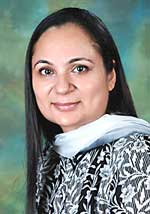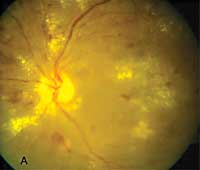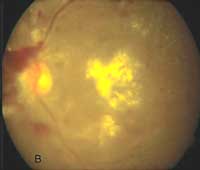Retina specialist takes on tuberculosis, diabetes and infection in India
Many ophthalmologists in India are concentrating on conquering cataract, but Vishali Gupta, MS, found her passion for ophthalmology elsewhere.
“Just after my graduation, I worked in a research project on diabetic retinopathy. It was about the comparison between different laser wavelengths, and I fell so much in love with the retina that I decided to be a retina expert even before joining ophthalmology,” she told Ocular Surgery News in a telephone interview. “When I saw the fundus pictures and the fluorescein angiograms for the first time, I got so fascinated with them that I wanted to keep looking at them for the rest of my life.”
Since then, Dr. Gupta has expanded her areas of expertise to include uveitis and other ocular infections germane to India.
“I love the challenge involved in making a definitive diagnosis and managing the patients with uveitis. It is not straightforward at all. Nothing is black and white in uveitis, every patient is a challenge,” she said. “Most of the ophthalmologists, especially in India, don’t like to manage these patients because they don’t get good returns. The majority want to do cataract. So I practice uveitis because I feel that these patients deserve more time and atten- tion than other ophthalmic patients. … Uveitis I do out of my compassion for these patients.”
Tackling diabetes
 Vishali Gupta, MS, says there should be continuing medical education standards for all Indian ophthalmologists. Image: Gupta V
|
With her initial research into diabetic retinopathy, Dr. Gupta found that there was much to do for this group of patients.
Patients with diabetes in India are probably less well-controlled systemically than in other parts of the world. Many times, patients with diabetes may walk into an ophthalmologist’s office with an advanced retinopathy and little understanding of their disease and its ocular complications, she said.
“A majority of the patients presenting with diabetic macular edema have elevated serum lipids, along with uncontrolled diabetes and hyper- tension, and if we go by the routine practice, we have to do the laser photocoagulation,” Dr. Gupta said. “When we do the laser photocoagulation in such a setting, all the lipids tend to migrate toward the center of the fovea and can result in permanent impairment of the vision.
“We found that we can achieve a good metabolic control, along with lowering their serum lipids, and it generally takes about 4 to 6 months to do so with the help of an endocrinologist. But once we are able to achieve that and then do the laser photocoagulation, we can actually improve the final visual outcome,” she said.
Although cataract is a large problem and it is being managed well in India, Dr. Gupta warned that the country is also “the world capital of diabetes,” and ophthalmologists are integral to fighting the ocular complications of this disease.
“Our youngsters have to prepare to face the challenge to be able to diagnose diabetic retinopathy, to be able to manage it with the lasers and also to know when to refer the patients for surgery,” she said. “We should get up and meet with the challenge of the burgeoning number of diabetic patients.”
Knowledge of geographic infections
One of the other challenges that Indian ophthalmologists face is the variety of infections found in their geographic region, Dr. Gupta said, pointing specifically to uveitis and endophthalmitis.
“Uveitis has variable geographic and ethnic variations. It varies from one country to the other,” she said. “We have to understand the spectrum of the disease in our own population, and only then, we shall be able to devise or modify the methods to treat. Managing uveitis is not synonymous with administering corticosteroids.”
Ophthalmologists in India should first rule out infective uveitis, as that is common in the geographic region, Dr. Gupta said.
“In a setting like ours, any endophthalmitis, whether exo or endogenous, should be considered as infective until proven otherwise,” she said.
With endophthalmitis, it is more common to see fungal endophthalmitis in Southeast Asia than in many other countries for various reasons, Dr. Gupta said.
One study she and colleagues published showed that local medical practitioners were treating patients with contaminated intravenous dextrose, and after 4 to 6 weeks of receiving this contaminated infusion, the patients would develop fungal endophthalmitis.
“That’s a kind of public health issue here, and recently a similar report has appeared from China, as well,” Dr. Gupta said.
The other incidences of fungal endophthalmitis that she has seen were referred to her institution after cataract surgery.
“This happens because the solutions that we are using, including the viscoelastics, can be compromised, and also our environment is dusty and the dust particles may carry the fungal spores,” Dr. Gupta said. “Now, if we are injecting the inoculum of the fungus into the eye, the endophthalmitis would not take 6 months to manifest. It could just be seen within 48 to 72 hours and would resemble a bacterial endophthalmitis.”
Thus, it is important that the ophthalmologists rule out fungal endophthalmitis before assuming it to be bacterial, she said.
 Left eye of a patient with type 2 diabetes who presented with macular edema and severe nonproliferative diabetic retinopathy. The patient received laser photocoagulation for macular edema without reinforcing metabolic control. |
 The same eye 6 weeks later shows foveal migration of the hard exudates. The visual acuity of the patient was reduced from 20/100 to counting fingers. Images: Gupta V
|
|
Tuberculosis
One of Dr. Gupta’s greatest accomplishments, she said, is helping uncover the connection between serpiginous choroiditis and tuberculosis.
“Serpiginous choroiditis has always been believed to be an autoimmune disease which would be treated by corticosteroids and immunosuppression,” Dr. Gupta said.
She and colleagues, although, showed that many patients had underlying tuberculosis.
“So if one sees a patient with serpiginous choroiditis, it does not always mean that would be autoimmune. It could have an underlying [tuberculosis], and especially in a community like ours,” she said. “This association is commonly seen in people from Southeast Asian countries. The underlying causative agents may be different in different parts of the world, but when we get serpiginous choroiditis … we are actually looking for [tuberculosis] in these patients.”
To test for this and other difficult diagnoses, Dr. Gupta said ophthalmologists rely on conventional tests such as purified protein derivative skin test and polymerase chain reaction (PCR).
“We have developed multiplex PCRs, like a triplex PCR for toxoplasmosis, tuberculosis and fungus, a combination that is relevant to us,” she said.
New imaging technology
Another advance in diagnosing retinal diseases is optical coherence tomography.
“I remember Prof. [Amod] Gupta telling me that you have to chase some of these patients with retinal diseases to their grave if you want to know what is happening inside their retina,” Dr. Gupta said, laughing. “We really wanted to see as to what was happening within the layers of the retina.”
When OCT was introduced, she said she was drawn to the images.
“As I started using it more and more, we started learning a lot of things about it, which changed our practice management because we are in a busy clinic which includes about 200 retina patients a day,” she said. “For fluorescein angiograms, one needs an appointment. Also, it’s an invasive procedure, and we’ve got to be careful, but OCT was just wonderful. I like it because it is noninvasive — quick to perform with the information that helps me in managing my patients better.”
Today, Dr. Gupta said she and colleagues are studying spectral domain OCT for additional information about various disease mechanisms.
Technology and education
Technology, such as OCT, is rapidly advancing in ophthalmology, and although access to the technology is not an obstacle, good use in clinical practice requires more education, Dr. Gupta said.
“Technology is not a problem in India. The application of technology might be,” she said. “If an ophthalmologist acquires a new machine, he/she tends to make most of his/her patients undergo that particular test. To me, that’s not the point of having the technology. The point of having the technology is that it helps you in the better management of the patient.”
Not every patient needs every test, Dr. Gupta said. She herself subscribes to a tailored approach in which she knows for what she is searching.
“Should I get the answer from that investigation, be it OCT, be it fluorescein angiogram or laboratory investigations, I must know how the answer from that investigation is going to help me in my patient’s management,” she said. “We are having so much technology in ophthalmology now. It is easy to get confused, and it’s plain to see that we are losing our clinical acumen. It is common, especially among the youngsters who must remember that many questions can be answered by just looking into the eye of the patient. Technology is a support. It’s not our master.”
Dr. Gupta said she feels that Indian ophthalmologists should be held to a continuing medical education regimen to maintain their knowledge in the field.
“Right now, we don’t have any such system. It’s your own initiative, whether one goes and attends the conferences and meetings or not,” she said. “If we look at the villages where a majority of the Indians reside, the ophthalmologists working at this root level may not know actually what advancements are happening in the world or even in their own country or even next door. This would mean depriving a large population from the benefits of advances in the diagnosis and management.”
Compulsory education, Dr. Gupta said, would allow these ophthalmologists the knowledge to at least refer patients to the correct center.
“They can at least give the right suggestion to the patient, which is important because patients on their own will not know where to go,” she said. “If the doctor tells them, ‘This is the center you go to for this problem,’ it solves so much of the hassle because [otherwise] the patient moves from one doctor to another, to the third doctor, and by the time he actually reaches the right doctor, sometimes the game is over. It’s already a lost battle.”
Obviously, Dr. Gupta said, the ultimate goal would to be to have the primary physician be able to treat, but that goal will take time to achieve.
“Until the time we reach that goal, at least the primary contact should be knowledgeable and that we can achieve only with continuing medical education, which I personally feel should be mandatory,” Dr. Gupta said. — by Katrina Altersitz
References:
- Gupta A, Gupta V, Dogra MR, et al. Fungal endophthalmitis after a single intravenous administration of presumably contaminated dextrose infusion fluid. Retina. 2000; 20(3):262-268.
- Gupta A, Gupta V, Thapar S, Bhansali A. Lipid-lowering drug atorvastatin as an adjunct in the management of diabetic macular edema. Am J Ophthalmol. ; 137(4):675-682.
- Gupta V, Agarwal A, Gupta A, Bambery P, Narang S. Clinical characteristics of serpiginous choroidopathy in North India. Am J Ophthalmol. 2002; 134:47-56.
- Gupta V, Gupta A, Arora S, Bambery P, Dogra MR, Agarwal A. Presumed tubercular serpiginouslike choroiditis: clinical presentations and management. Ophthalmology. 2003; 110:1744-1749.
- Gupta V, Gupta A, Gupta P, Sharma A Spectral-Domain Cirrus Optical Coherence Tomography of Choroidal Striations Seen in the Acute Stage of Vogt-Koyanagi-Harada Disease. Am J Ophthalmol. 2008 Sep 30. [Epub ahead of print]
- Gupta V, Gupta A, Rao NA. Intraocular tuberculosis - an update. Surv Ophthalmol. 2007; 52;561-587.
- Gupta V, Gupta P, Singh R, Dogra MR, Gupta A. Spectral-domain Cirrus high-definition optical coherence tomography is better than time-domain Stratus optical coherence tomography for evaluation of macular pathologic features in uveitis. Am J Ophthalmol. 2008; 145;1018-1022.
- Narang S, Gupta A, Gupta V, et al. Fungal endophthalmitis following cataract surgery: clinical presentation, microbiological spectrum, and outcome. Am J Ophthalmol. 2001; 132(5):609-617.
- Vishali Gupta, MD, can be reached at the Department of Ophthalmology, Advanced Eye Centre, Postgraduate Institute of Medical Education and Research, Chandigarh -160012, India; +91-172-2747837; fax: +91-172-2747837; e-mail: vishalisara@yahoo.com.

